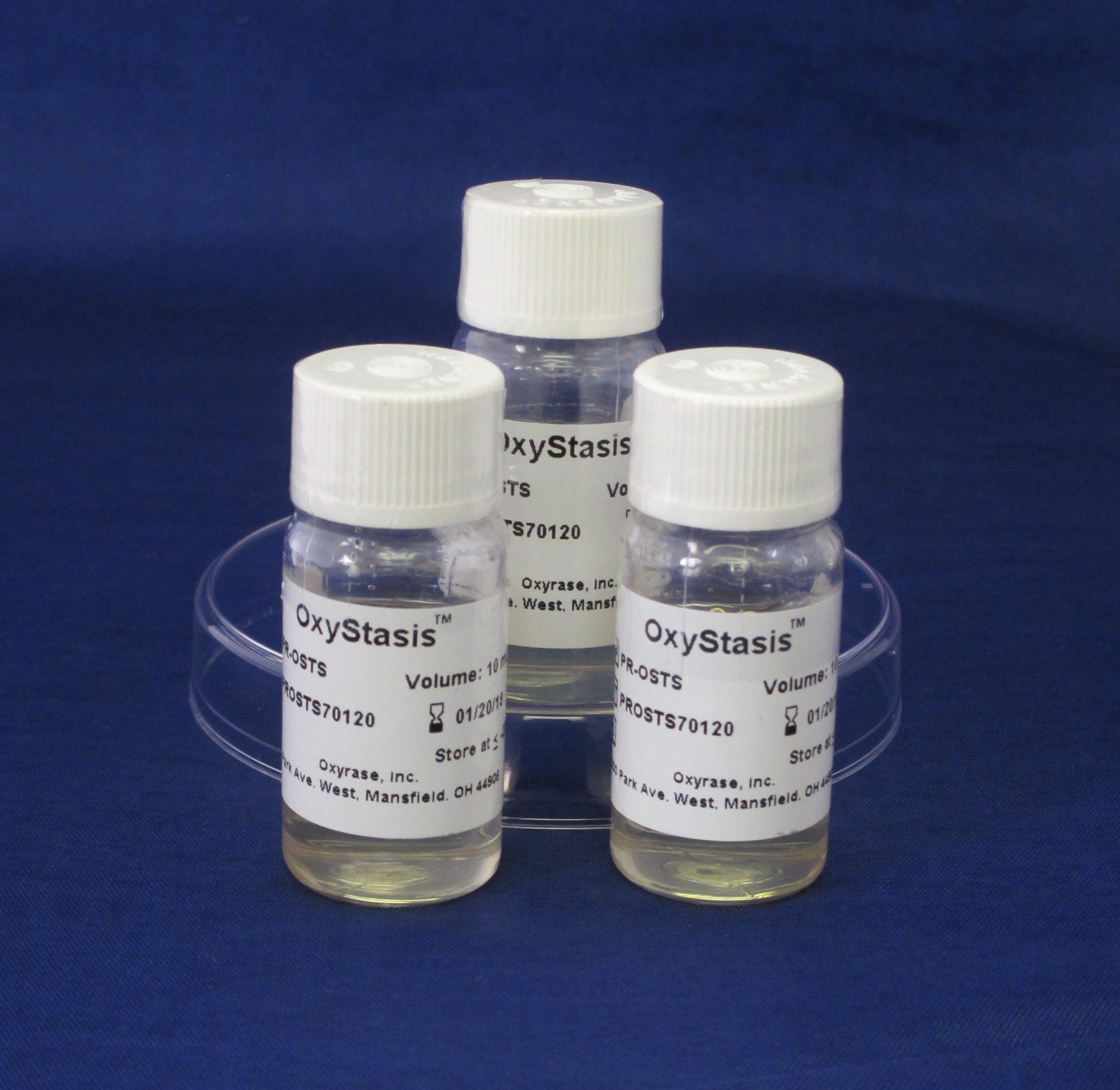OxyStasis™
The idea b ehind OxyStasis™ is to produce a condition where biological material can be preserved at a reduced temperature, in a stable environment, without ice formation, without oxidation and as a result no damage.
ehind OxyStasis™ is to produce a condition where biological material can be preserved at a reduced temperature, in a stable environment, without ice formation, without oxidation and as a result no damage.
If ice formation can be prevented, damage to biological structures from ice crystal formation will not occur. With OxyStasis™ this is possible and the biological material may still be stored at temperatures below freezing, slowing down or preventing normal chemical reactions from occurring.
The resulting static condition, combined with the reduced environment created by the Oxyrase® Enzyme System, acts to protect cells and tissues from damage during long term storage.
A preservation cycle is not complete without the ability to recover the material. The liquid nature of OxyStasis™ also makes this phase of the preservation process much more simplified.
Background
Traditional freezer storage and preservation of biological materials is fairly common in many facilities. Depending on the objectives the freezing conditions will vary from normal freezer temperatures (≤ -20°C) to cryo-freezing temperatures (≤ -70°C). Generally, the colder the temperature the longer the specimens can be stored. [1]
Unfortunately freezing biological material is not without problems. Most frequently ice crystal formation is cited as a significant limitation. Since biological materials tend to be high in water content (~80% on average) the formation of ice crystals is almost inevitable. Ice crystals are thought to produce physical damage to cells and tissues. Cell damage mostly occurs during the freezing step; although damage can also occur during the thawing process as well. [2]
Freeze drying or lyophilization can sometimes be an alternative to liquid freezing biological materials. However, this process, where the material is brought down to freezing temperatures while moisture is removed resulting in a dried powder, is not without issue and is far from ideal for many specimen types. [3]
Furthermore, damage to biological materials, caused by freezing or freeze-drying, is inconsistent with the concept of preservation. If after freezing, the recovered portion of the initial population of sample is small (<1:100) it raises the question "are survivors truly representative of the initial population?" In some cases the recoverable portion of cells after freeze-drying represents only 1:1,000,000 the initial population. Thus, methods of preservation that retain a majority of the initial population are favored over methods that do not. [4]
A way to prevent or limit ice crystal damage to tissue is to bring the material to a state where ice crystals are not formed. This is often referred to as the "glass state." In this state, ice is considered an amorphic solid, the water molecules are arranged randomly. In regular ice, the water molecules are arranged in a hexagonal lattice. The production of amorphous ice depends on a fast rate of cooling to approximately -137°C. If ice crystals are not formed, then freeze damage can be limited. [5]
OxyStasis™ Characteristics
The preservation characteristics of OxyStasis™ have been achieved by using elevated concentrations of cryoprotectants to lower the freezing point of the mixture used to preserve cells.
Additionally, the presence of the Oxyrase® Enzyme System and substrates in OxyStasis™ provides a stable, reduced environment in which cells are protected from the deleterious effects of oxidation. The longer the cells are preserved, the more important protection from oxidation becomes.
We have stored a panel of microorganisms, preserved in OxyStasis™, for periods >15 months in a standard household freezer and recovered high numbers of viable cells. It is not surprising that since the medium does not freeze we achieved quantitative recovery of the microorganisms. In addition, the microbial cells were not adversely affected by the high concentrations cryoprotectants. Given this data, it may be possible for cells to be stored for extraordinarily long periods of time in OxyStasis™.
An added benefit that is realized from the non-freezing nature of OxyStasis™ is that a wide range of freezer equipment can be used, including a standard household freezer, to accomplish long term preservation of biological material. A standard household freezer may have frequent self-defrost cycles where the temperatures can reach as high as -5°C for extended periods before returning to <-20°C. Our studies have shown long term preservation can still be accomplished without cellular damage. This observation has significant financial implications for organizations otherwise faced with disproportionately high capital equipment costs related to traditional cryo-freezers and their associated supplies and equipment.
It also should not be overlooked that working with cells or biological material in a liquid suspension is often considerably faster, easier and less costly than working with frozen suspensions that need to be thawed before the material can be recovered.
OxyStasis™ provides several important advantages to traditional preservation methods for biological materials.
OxyStasis Minimum Order 50 x 10mL bottles. This is a Custom Order with a 4 week Lead Time.
To see our other Preservation Products click here.
References:
- Mazur P, (May 1970). "Cryobiology: the freezing of biological systems". Science 22; 168 (3934): 939-49.
- McGann LE, Yang HY, Walterson M, (June 1988). "Manifestations of cell damage after freezing and thawing". Cryobiology 25 (3): 178-85.
- Jennings TA, Lyophilization: Introduction and Basic Principles (1999). Taylor & Francis Inc.
- Fowler A, Toner M, (December 2005). "Cryo-injury and biopreservation". Ann N Y Acad Sci 1066: 119-35.
- Debennetti, Pablo G; H. Eugene Stanley. (June 2003) "Supercooled and Glassy Water". Physics Today 56: 40–46.
Products and Pricing
| OxyStasis™ (1x10mL) Minimum Order 50 |
PR-OSTS Product Insert |
X $30.33 | Add To Cart |
Product Insert
OxyStasis™ (PR-OSTS)
Download
SDS
OxyStasis‚ĄĘ SDS
Download



